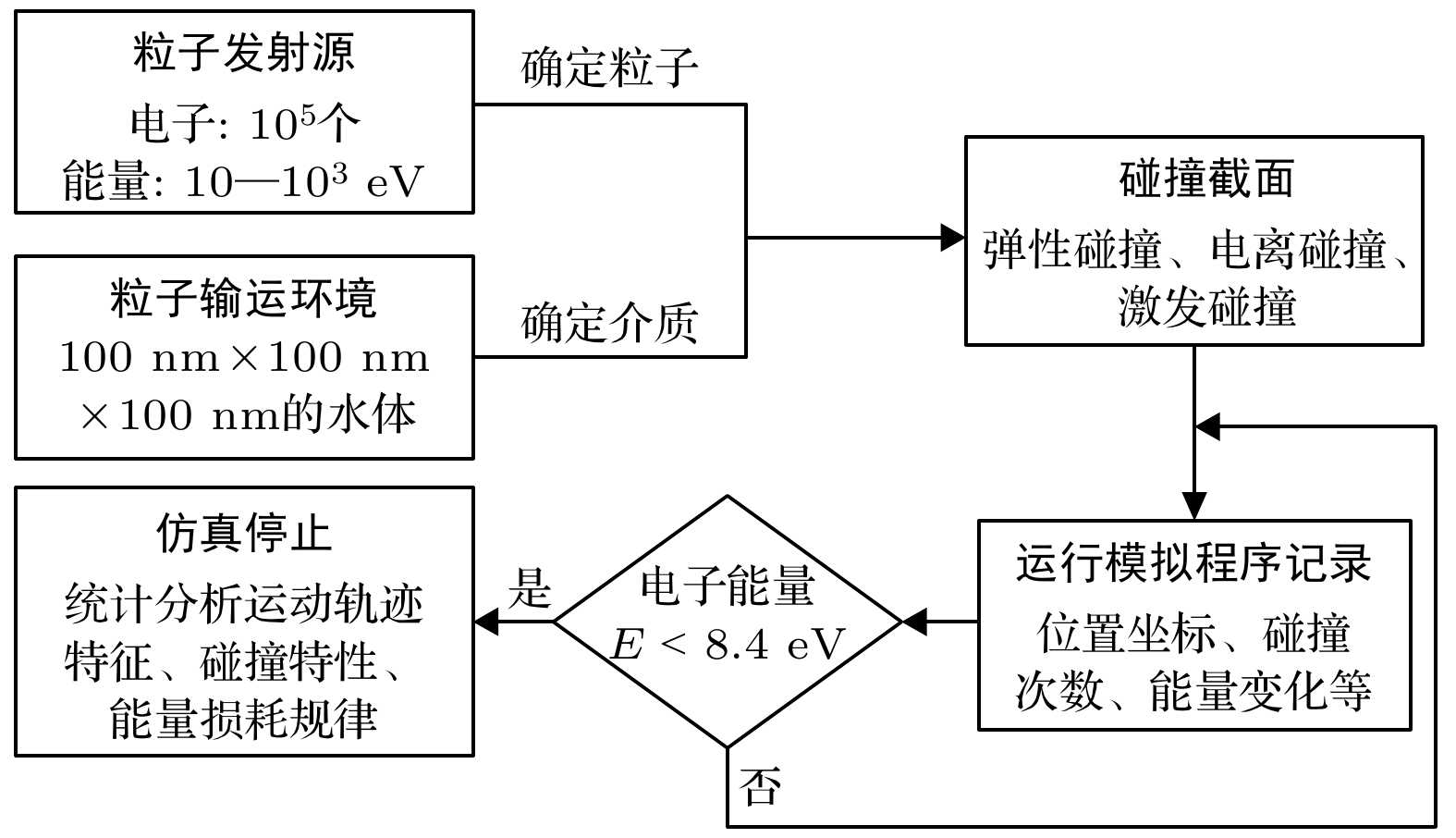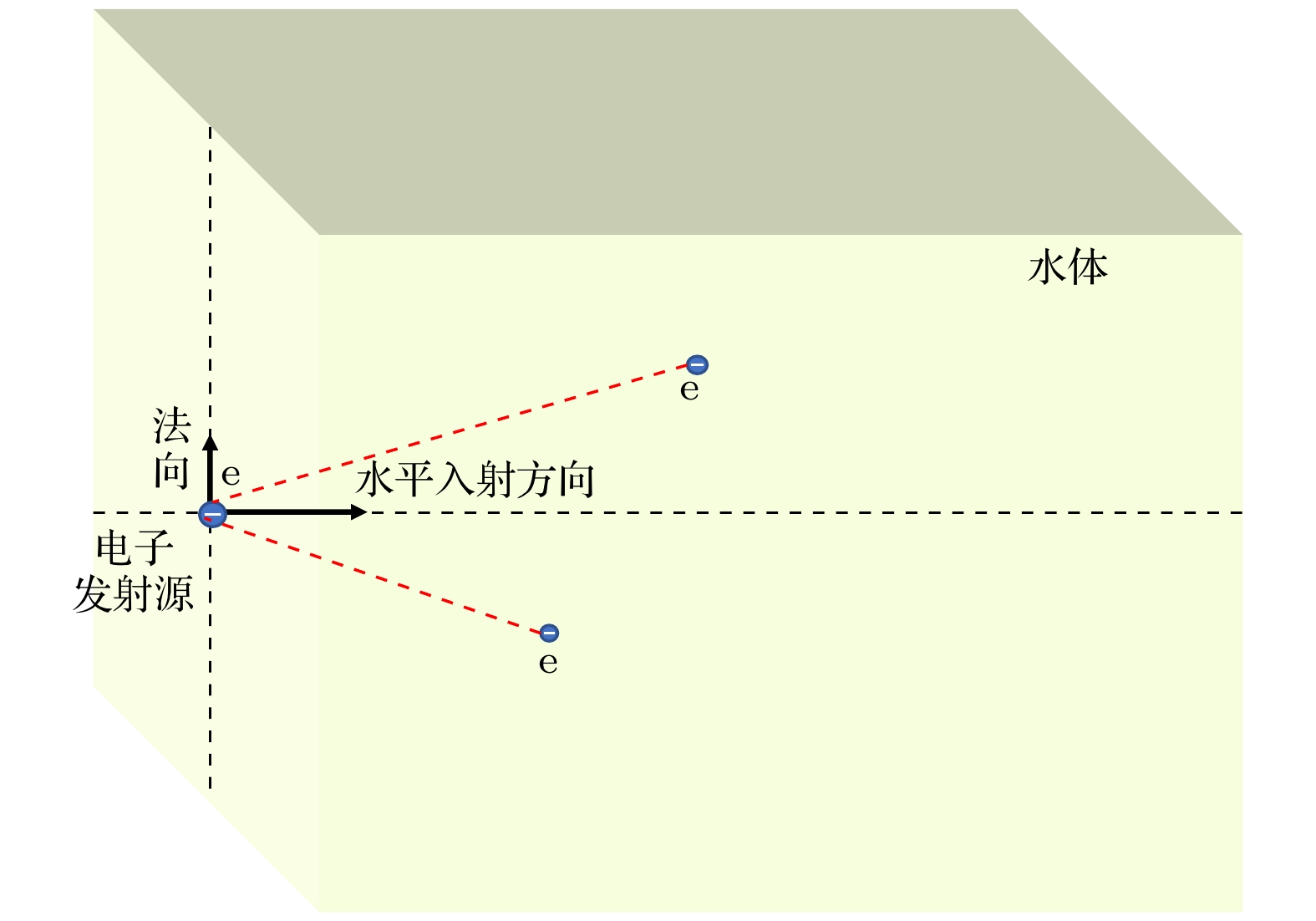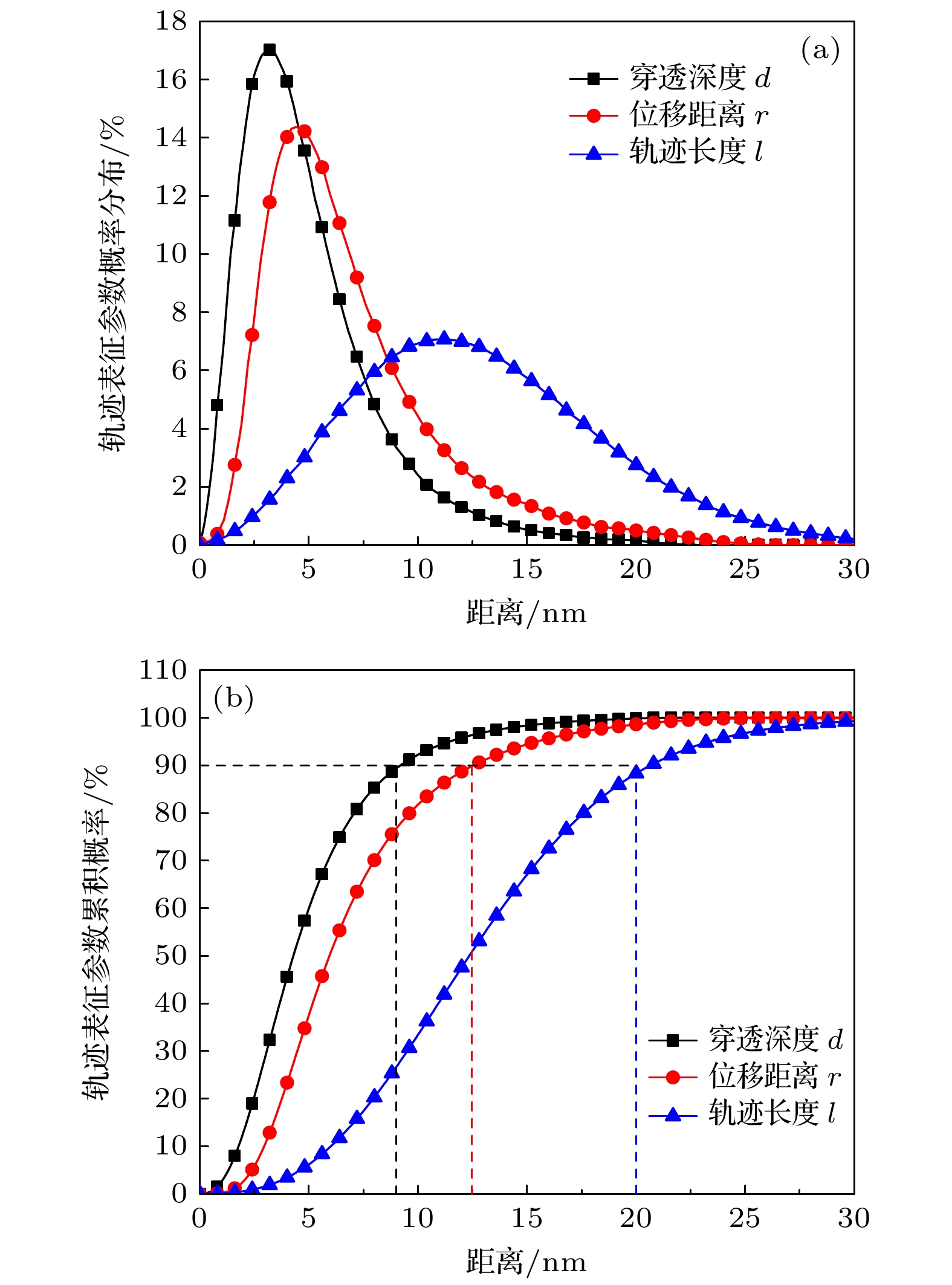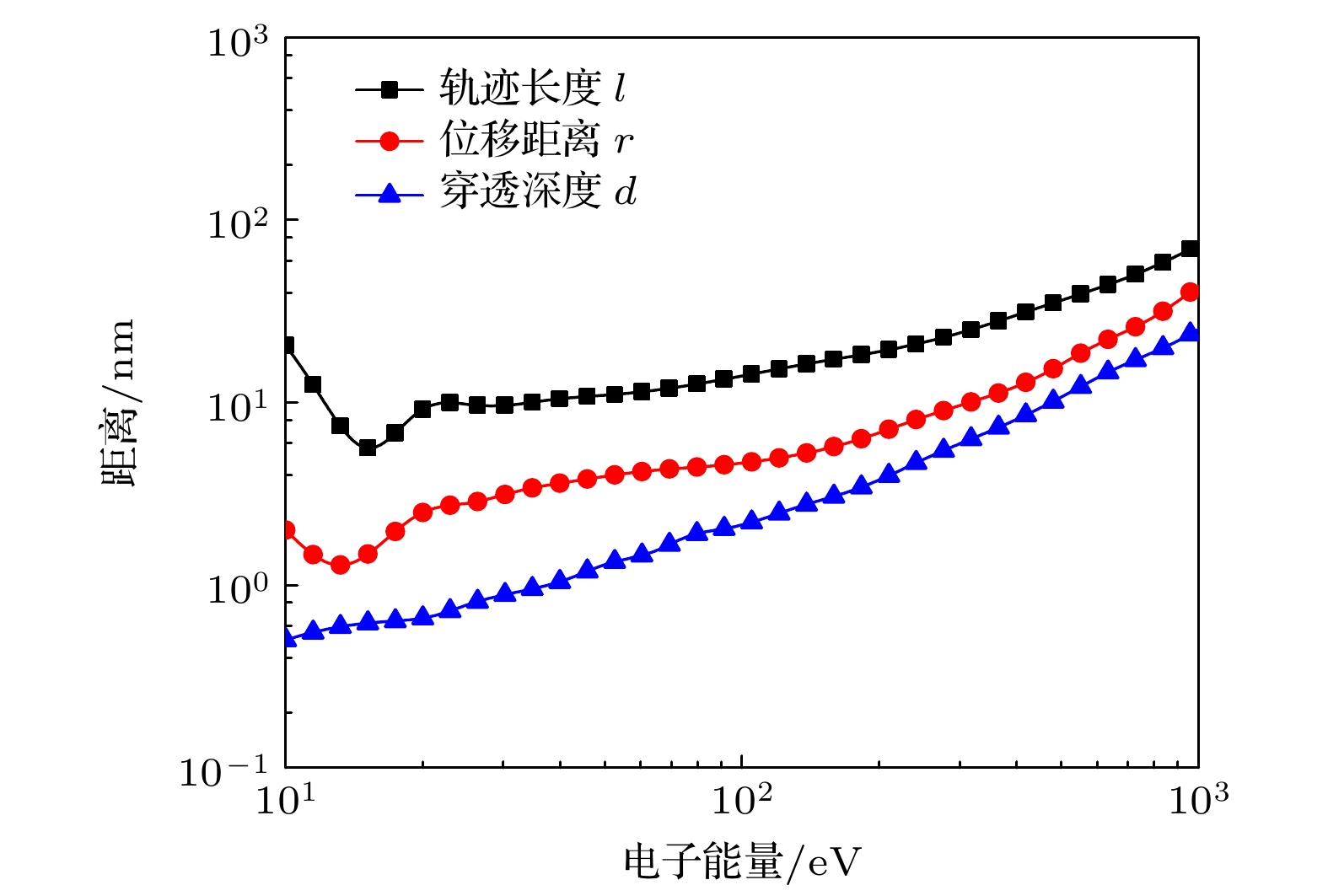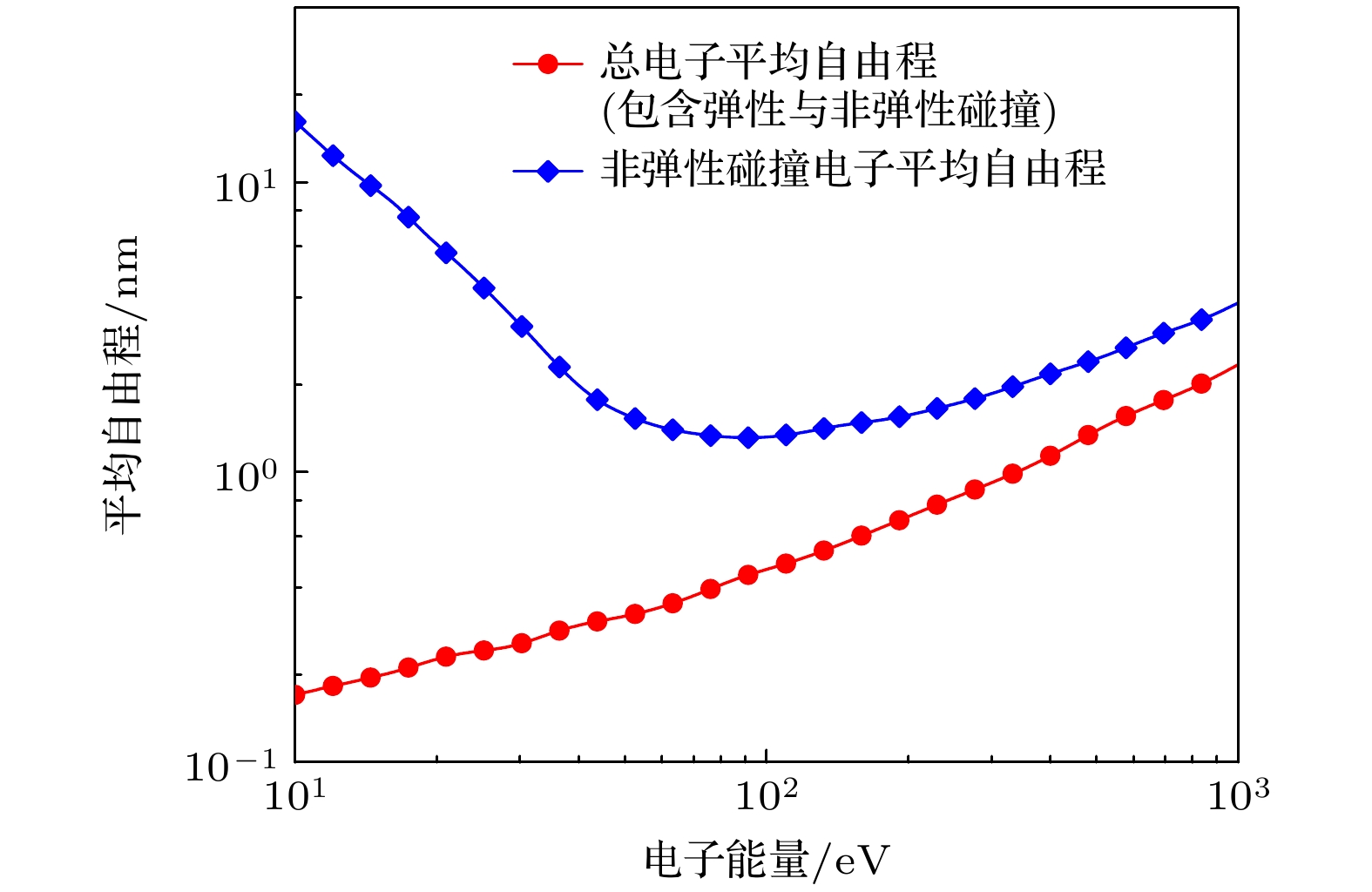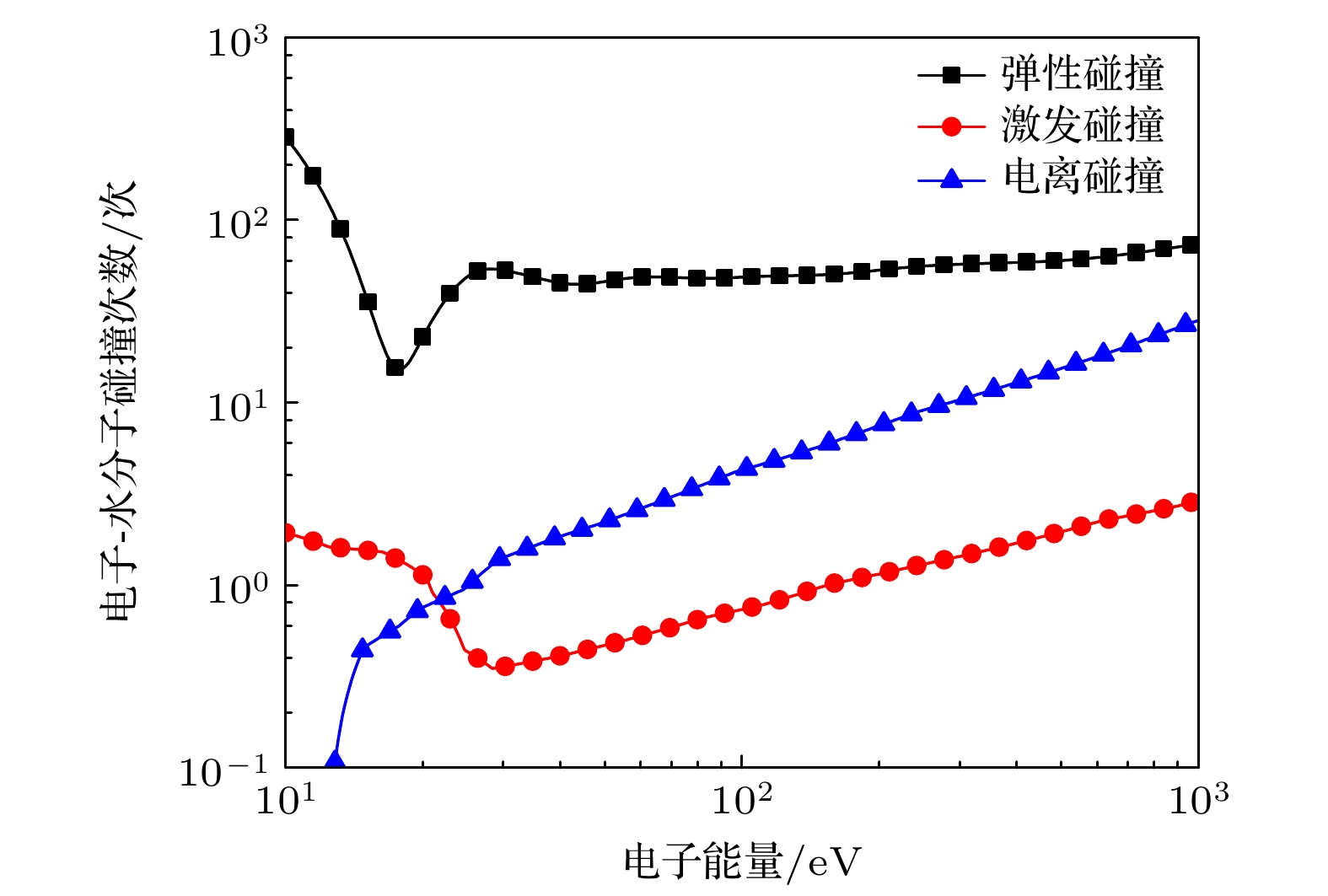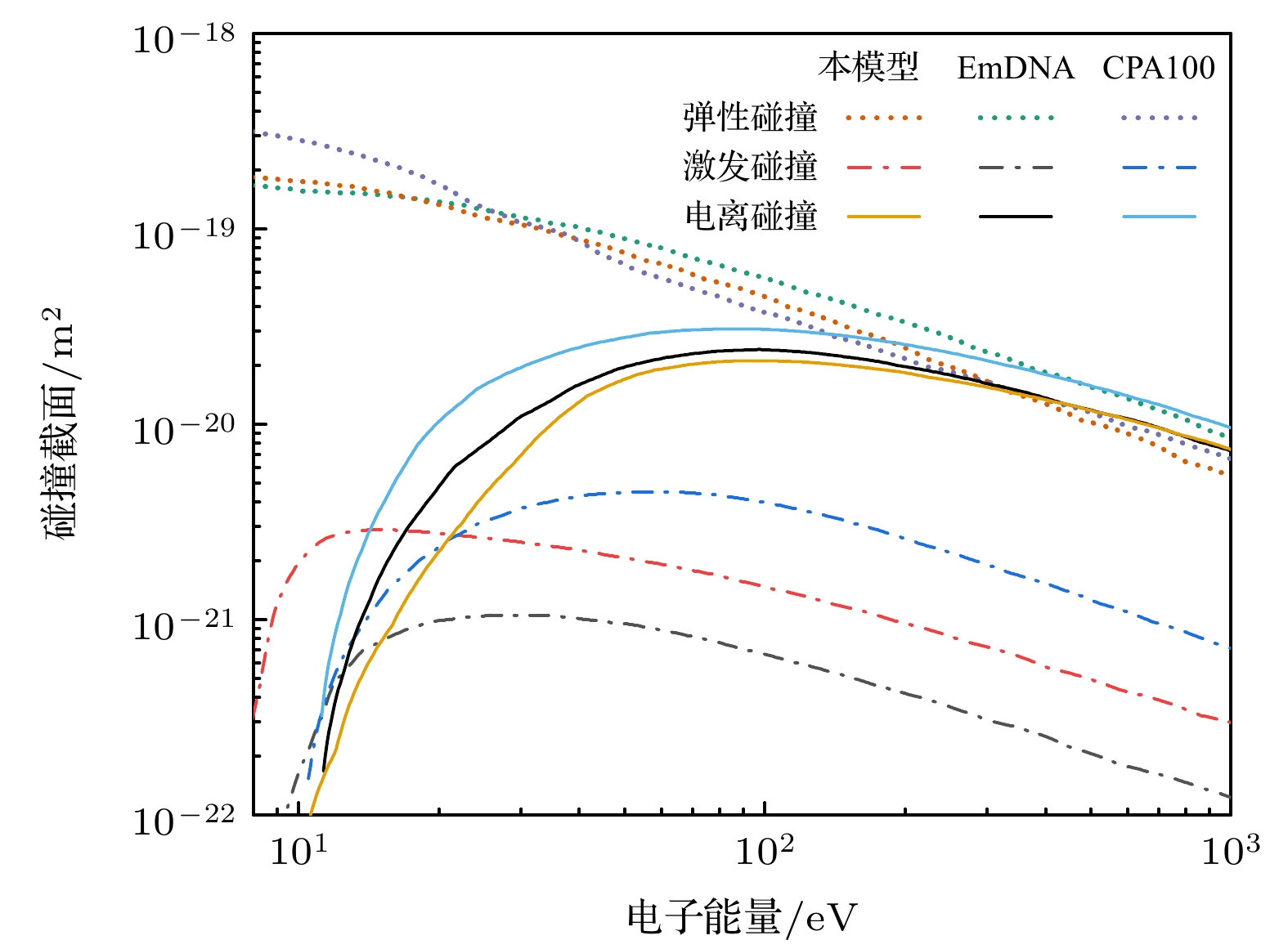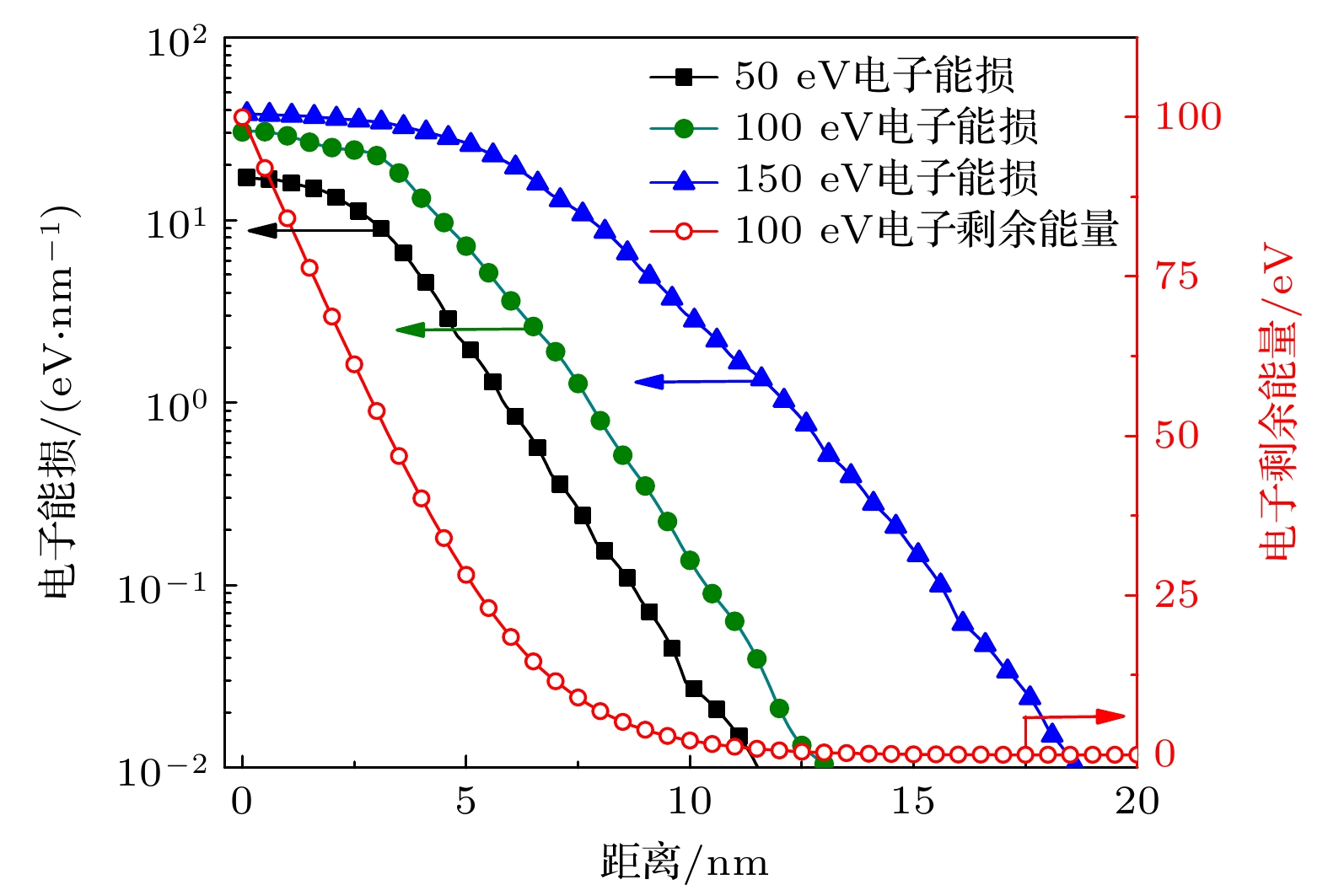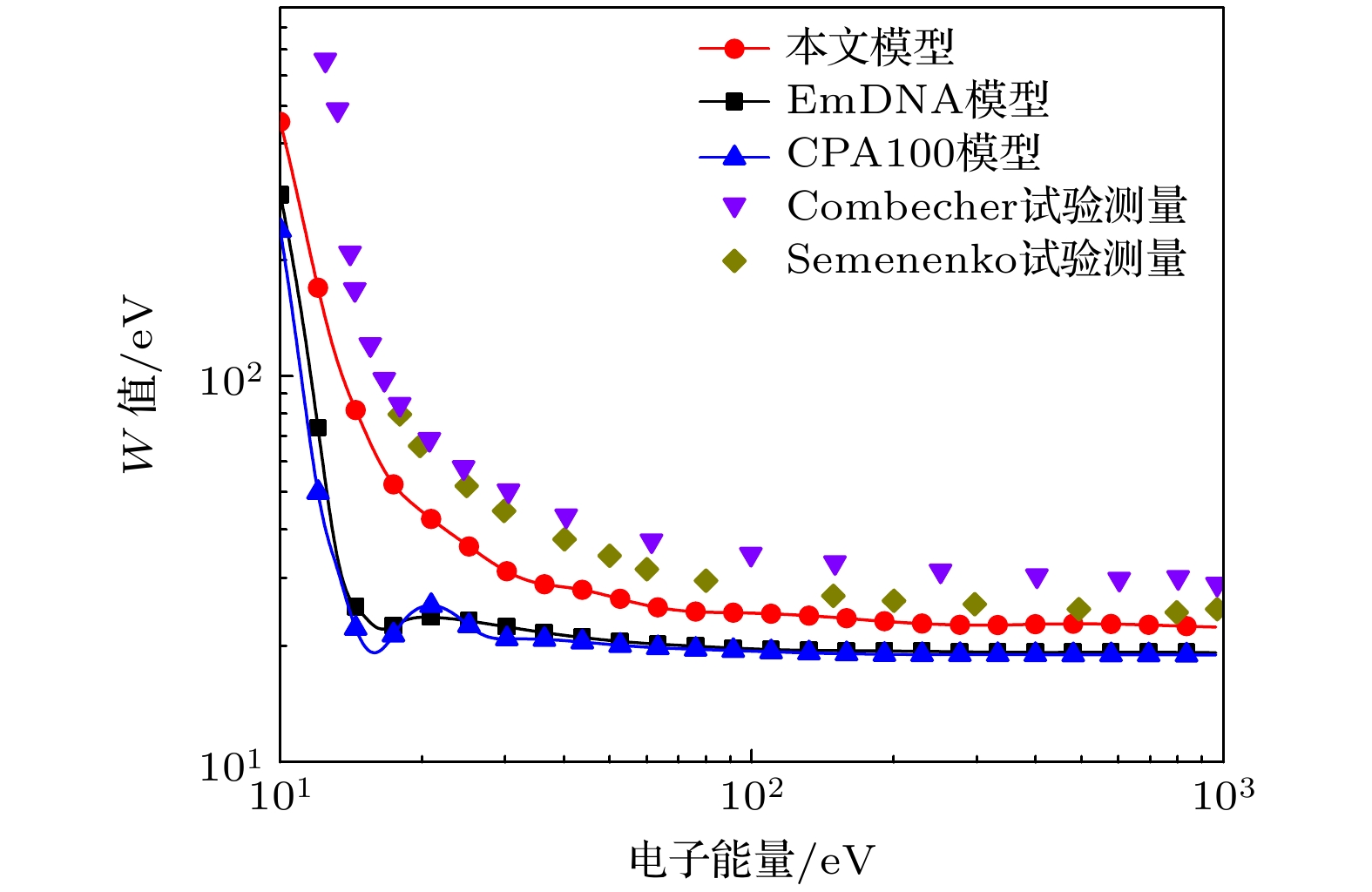-
水中快脉冲(脉宽数ns甚至ps级)放电过程中, 快脉冲在电极附近引起电致伸缩效应导致电极附近形成空化区. 电子在空化区内积累能量并高速进入水体, 电子在水中的输运特性是水中脉冲放电起始与发展的关键因素. 本文构建了考虑弹性与非弹性碰撞截面的水中电子输运物理模型, 采用蒙特卡罗方法研究不同能量电子的透射与散射径迹结构特征, 研究了弹性碰撞、电离与激发碰撞频次随电子初始能量的变化以及水中电子能量损失特征. 结果表明, 较低能量的电子(约20 eV)受水分子散射影响能量损失较大, 透射能力较弱, 随着电子初始能量的增高, 电子受水分子散射作用的影响逐渐减小, 具有更强的液体穿透能力; 弹性碰撞次数远大于激发与电离碰撞, 导致电子散射距离与透射深度相当, 电离碰撞和激发碰撞次数随电子能量升高显著增加; 电子入射能量越高, 其能损越大, 随运动距离增加, 能损急剧下降, 与电子的平均电离能量损失W变化趋势一致. 本研究可为探究快脉冲放电机理提供重要数据基础.The transport characteristics of electrons are crucial for the initiation and development of pulse discharge in water. In this work, we develop a physical model of electron transport that consides elastic and inelastic collision cross sections. The purpose of this study is to investigate frequency variations of elastic collisions, ionization and excitation collisions with different initial electron energy values, and to explore the characteristic of electron energy loss in water. The Monte Carlo method is employed to track structure characteristics of electron transmission and scattering under varying energy values. The results show that the electrons of lower energy (~20 eV) are significantly impacted by the water molecule scattering, hence their transmission capacities are weakened. When the incident energy of electron reaches 100 eV, the scattering deviation distance is roughly equivalent to the transmission depth, about 6–8 nm, and the maximum deviation angle θshift ~ 60°. When the electron incident energy is in a range of 10–1000 eV, the number of elastic collisions is much greater than the number of excitation and ionization collisions, and the number of ionization collisions and excitation collisions increases significantly with the increase of electron energy. The higher the electron incident energy, the greater the energy loss is. However, the energy loss decreases sharply with the extension of penetration distance. For the ionization collision, the average ionization energy loss, W, decreases rapidly with the increase of electron energy, and ultimately maintains at a level of 20–30 eV, which is consistent with the experimental results reported.
-
Keywords:
- electrostrictive effect /
- electron transport in water /
- transmission and scattering /
- collision type
[1] 赵景林, 王志强, 王进君, 张东东, 李国锋 2023 强激光与粒子束 35 035005
 Google Scholar
Google Scholar
Zhao J L, Wang Z Q, Wang J J, Zhang D D, Li G F 2023 High Power Laser Part. Beams 35 035005
 Google Scholar
Google Scholar
[2] Wang L R, Wen X Q, Yang Y T, Wang X 2023 J. Appl. Phys. 134 013302
 Google Scholar
Google Scholar
[3] 李显东, 刘毅, 周古月, 刘思维, 李志远, 林福昌, 潘垣 2018 中国电机工程学报 38 1562
 Google Scholar
Google Scholar
Li X D, Liu Y, Zhou G Y, Liu S W, Li Z Y, Lin F C, Pan Y 2018 Proceeding of the CSEE 38 1562
 Google Scholar
Google Scholar
[4] 尤特金 1962 液电效应 (北京: 科学出版社) 第45—50页
Yutkin 1962 Electro-hydraulic Effect (Beijing: Science Press) pp45–50
[5] 李元, 李林波, 温嘉烨, 倪正全, 张冠军 2021 物理学报 70 024701
 Google Scholar
Google Scholar
Li Y, Li L B, Wen J Y, Ni Z Q, Zhang G J 2021 Acta Phys. Sin. 70 024701
 Google Scholar
Google Scholar
[6] Seepersad Y, Pekker M, Shneider M N, Fridman A, Dobrynin D 2013 J. Appl. Phys. 46 355201
 Google Scholar
Google Scholar
[7] Shneider M, Pekker M, Fridman A 2012 IEEE Trans. Dielectr. Electr. Insul. 19 1579
 Google Scholar
Google Scholar
[8] Shneider M N, Pekker M 2013 J. Appl. Phys. 114 214906
 Google Scholar
Google Scholar
[9] Pekker M, Shneider M N 2017 Fluid Dyn. Res. 49 035503
 Google Scholar
Google Scholar
[10] Aghdam A C, Farouk T 2020 Plasma Sources Sci. Technol. 29 025011
 Google Scholar
Google Scholar
[11] 涂婧怡, 陈赦, 汪沨 2019 物理学报 68 095202
 Google Scholar
Google Scholar
Tu J Y, Chen S, Wang F 2019 Acta Phys. Sin. 68 095202
 Google Scholar
Google Scholar
[12] 张晋琪, 蒋兴良, 陈志刚 2006 强激光与粒子束 1 18 1053
Zhang J Q, Jiang X L, Chen Z G 2006 High Power Laser Part. Beams 18 1053
[13] 李元, 温嘉烨, 李林波, 郜晶, 石亚轩, 刘志濠, 张冠军 2021 强激光与粒子束 33 065001
 Google Scholar
Google Scholar
Li Y, Wen J Y, Li L B, Gao J, Shi Y X, Liu Z H Zhang G J 2021 High Power Laser Part. Beams 33 065001
 Google Scholar
Google Scholar
[14] Chen X, Li, C, Ke K 2017 Chin. Sci. Bull. 62 2866
 Google Scholar
Google Scholar
[15] Wen X Q, Zhou Y B, Xue X D, Yang Y T 2021 Phys. Plasmas 28 013507
 Google Scholar
Google Scholar
[16] Yang Y T, Wen X Q, Wang L R, Wang X 2022 Phys. Plasmas 29 093501
 Google Scholar
Google Scholar
[17] 尹昊, 宋通, 彭雄刚, 张鹏, 于润升, 陈喆, 曹兴忠, 王宝义 2023 物理学报 72 114101
 Google Scholar
Google Scholar
Yin H, Song T, Peng X G, Zhang P, Yu R S, Chen Z, Cao X Z, Wang B Y 2023 Acta Phys. Sin. 72 114101
 Google Scholar
Google Scholar
[18] 赵喆, 卢岳, 张振华, 隋曼龄 2019 物理化学学报 35 539
 Google Scholar
Google Scholar
Zhao Z, Lu Y, Zhang Z H, Sui M L 2019 Acta Phys. -Chim. Sin. 35 539
 Google Scholar
Google Scholar
[19] Damascelli A, Hussain Z, Shen Z X 2003 Rev. Mod. Phys. 75 473
 Google Scholar
Google Scholar
[20] 赵林, 刘国东, 周兴江 2021 物理学报 70 017406
 Google Scholar
Google Scholar
Zhao L, Liu G D, Zhou X J 2021 Acta Phys. Sin. 70 017406
 Google Scholar
Google Scholar
[21] Bousis C, Emfietzoglou D, Hadjidoukas P, Nikjoo H, Pathak A 2008 Nucl. Instrum. Methods Phys. Res. Sect. B 266 1185
 Google Scholar
Google Scholar
[22] Dingfelder M, Ritchie R H, Turner J E, Friedland W, Paretzke H G, Hamm R N 2008 Radiat. Res. 169 584
 Google Scholar
Google Scholar
[23] Bordage M C, Bordes J, Edel S, Terrissol M, Franceries X, Bardiès M, Lampe N, Incerti S 2016 Physica Med. 32 1833
 Google Scholar
Google Scholar
[24] 谭震宇, 张黎明, 王晶, 高洪霞 2012 电工技术学报 27 1
 Google Scholar
Google Scholar
Tan Z Y, Zhang L M, Wang J, Gao H X, 2012 Trans. Chin. Electrotech. Soc. 27 1
 Google Scholar
Google Scholar
[25] Uehara S, Nikjoo H, Goodhead D T 1992 Phys. Med. Biol. 37 1841
 Google Scholar
Google Scholar
[26] Emfietzoglou D, Papamichael G, Androulidaki I, Karava K, Kostarelos K, Pathak A, Moscovitch M 2005 Nucl. Instrum. Methods Phys. Res. , Sect. B 228 341
 Google Scholar
Google Scholar
[27] Dingfelder M, Hantke D, Inokuti M, Paretzke H G 1998 Radiat. Phys. Chem. 53 1
 Google Scholar
Google Scholar
[28] Fernandez-Varea J M, Mayol R, Liljequist D, Salvat F 1993 J. Phys. Condens. Matter 5 3593
 Google Scholar
Google Scholar
[29] Vriens L 1966 Phys. Rev. 141 88
 Google Scholar
Google Scholar
[30] Emfietzoglou D, Nikjoo H A 2007 Radiat. Res. 167 110
 Google Scholar
Google Scholar
[31] Choi E, Chon K S, Yoon M G 2020 Radiat. Eff. Defects Solids 175 11
[32] Incerti S, Kyriakou I, Tran H N 2017 Nucl. Instrum. Methods Phys. Res. , Sect. B B 397 45
 Google Scholar
Google Scholar
[33] 李林波 2021 硕士学位论文 (西安: 西安交通大学)
Li L B 2021 M. S. Thesis (Xi'an: Xi'an Jiaotong University
[34] Wang D, Namihira T 2020 Plasma Sources Sci. Technol. 29 023001
 Google Scholar
Google Scholar
[35] Emfietzoglou D 2003 Radiat. Phys. Chem. 66 373
 Google Scholar
Google Scholar
[36] Combecher D 1980 Radiat. Res. 84 189
 Google Scholar
Google Scholar
-
表 1 电离能级与激发能级参数
Table 1. Ionization levels and excitation level parameters
电离能级 Bj (j = 1, 2···, 5)/eV Uj (j = 1, 2···, 5)/eV 激发能级 Ej (j = 6, 7···, 10)/eV 1b1 10 30 A1B1 8.40 3a1 13 40 B1A1 10.10 1b2 17 50 Ryd A+B 11.26 2a1 32.2 60 Ryd C+D 11.93 1a1 539.7 700 Diffuse bands 14.10 -
[1] 赵景林, 王志强, 王进君, 张东东, 李国锋 2023 强激光与粒子束 35 035005
 Google Scholar
Google Scholar
Zhao J L, Wang Z Q, Wang J J, Zhang D D, Li G F 2023 High Power Laser Part. Beams 35 035005
 Google Scholar
Google Scholar
[2] Wang L R, Wen X Q, Yang Y T, Wang X 2023 J. Appl. Phys. 134 013302
 Google Scholar
Google Scholar
[3] 李显东, 刘毅, 周古月, 刘思维, 李志远, 林福昌, 潘垣 2018 中国电机工程学报 38 1562
 Google Scholar
Google Scholar
Li X D, Liu Y, Zhou G Y, Liu S W, Li Z Y, Lin F C, Pan Y 2018 Proceeding of the CSEE 38 1562
 Google Scholar
Google Scholar
[4] 尤特金 1962 液电效应 (北京: 科学出版社) 第45—50页
Yutkin 1962 Electro-hydraulic Effect (Beijing: Science Press) pp45–50
[5] 李元, 李林波, 温嘉烨, 倪正全, 张冠军 2021 物理学报 70 024701
 Google Scholar
Google Scholar
Li Y, Li L B, Wen J Y, Ni Z Q, Zhang G J 2021 Acta Phys. Sin. 70 024701
 Google Scholar
Google Scholar
[6] Seepersad Y, Pekker M, Shneider M N, Fridman A, Dobrynin D 2013 J. Appl. Phys. 46 355201
 Google Scholar
Google Scholar
[7] Shneider M, Pekker M, Fridman A 2012 IEEE Trans. Dielectr. Electr. Insul. 19 1579
 Google Scholar
Google Scholar
[8] Shneider M N, Pekker M 2013 J. Appl. Phys. 114 214906
 Google Scholar
Google Scholar
[9] Pekker M, Shneider M N 2017 Fluid Dyn. Res. 49 035503
 Google Scholar
Google Scholar
[10] Aghdam A C, Farouk T 2020 Plasma Sources Sci. Technol. 29 025011
 Google Scholar
Google Scholar
[11] 涂婧怡, 陈赦, 汪沨 2019 物理学报 68 095202
 Google Scholar
Google Scholar
Tu J Y, Chen S, Wang F 2019 Acta Phys. Sin. 68 095202
 Google Scholar
Google Scholar
[12] 张晋琪, 蒋兴良, 陈志刚 2006 强激光与粒子束 1 18 1053
Zhang J Q, Jiang X L, Chen Z G 2006 High Power Laser Part. Beams 18 1053
[13] 李元, 温嘉烨, 李林波, 郜晶, 石亚轩, 刘志濠, 张冠军 2021 强激光与粒子束 33 065001
 Google Scholar
Google Scholar
Li Y, Wen J Y, Li L B, Gao J, Shi Y X, Liu Z H Zhang G J 2021 High Power Laser Part. Beams 33 065001
 Google Scholar
Google Scholar
[14] Chen X, Li, C, Ke K 2017 Chin. Sci. Bull. 62 2866
 Google Scholar
Google Scholar
[15] Wen X Q, Zhou Y B, Xue X D, Yang Y T 2021 Phys. Plasmas 28 013507
 Google Scholar
Google Scholar
[16] Yang Y T, Wen X Q, Wang L R, Wang X 2022 Phys. Plasmas 29 093501
 Google Scholar
Google Scholar
[17] 尹昊, 宋通, 彭雄刚, 张鹏, 于润升, 陈喆, 曹兴忠, 王宝义 2023 物理学报 72 114101
 Google Scholar
Google Scholar
Yin H, Song T, Peng X G, Zhang P, Yu R S, Chen Z, Cao X Z, Wang B Y 2023 Acta Phys. Sin. 72 114101
 Google Scholar
Google Scholar
[18] 赵喆, 卢岳, 张振华, 隋曼龄 2019 物理化学学报 35 539
 Google Scholar
Google Scholar
Zhao Z, Lu Y, Zhang Z H, Sui M L 2019 Acta Phys. -Chim. Sin. 35 539
 Google Scholar
Google Scholar
[19] Damascelli A, Hussain Z, Shen Z X 2003 Rev. Mod. Phys. 75 473
 Google Scholar
Google Scholar
[20] 赵林, 刘国东, 周兴江 2021 物理学报 70 017406
 Google Scholar
Google Scholar
Zhao L, Liu G D, Zhou X J 2021 Acta Phys. Sin. 70 017406
 Google Scholar
Google Scholar
[21] Bousis C, Emfietzoglou D, Hadjidoukas P, Nikjoo H, Pathak A 2008 Nucl. Instrum. Methods Phys. Res. Sect. B 266 1185
 Google Scholar
Google Scholar
[22] Dingfelder M, Ritchie R H, Turner J E, Friedland W, Paretzke H G, Hamm R N 2008 Radiat. Res. 169 584
 Google Scholar
Google Scholar
[23] Bordage M C, Bordes J, Edel S, Terrissol M, Franceries X, Bardiès M, Lampe N, Incerti S 2016 Physica Med. 32 1833
 Google Scholar
Google Scholar
[24] 谭震宇, 张黎明, 王晶, 高洪霞 2012 电工技术学报 27 1
 Google Scholar
Google Scholar
Tan Z Y, Zhang L M, Wang J, Gao H X, 2012 Trans. Chin. Electrotech. Soc. 27 1
 Google Scholar
Google Scholar
[25] Uehara S, Nikjoo H, Goodhead D T 1992 Phys. Med. Biol. 37 1841
 Google Scholar
Google Scholar
[26] Emfietzoglou D, Papamichael G, Androulidaki I, Karava K, Kostarelos K, Pathak A, Moscovitch M 2005 Nucl. Instrum. Methods Phys. Res. , Sect. B 228 341
 Google Scholar
Google Scholar
[27] Dingfelder M, Hantke D, Inokuti M, Paretzke H G 1998 Radiat. Phys. Chem. 53 1
 Google Scholar
Google Scholar
[28] Fernandez-Varea J M, Mayol R, Liljequist D, Salvat F 1993 J. Phys. Condens. Matter 5 3593
 Google Scholar
Google Scholar
[29] Vriens L 1966 Phys. Rev. 141 88
 Google Scholar
Google Scholar
[30] Emfietzoglou D, Nikjoo H A 2007 Radiat. Res. 167 110
 Google Scholar
Google Scholar
[31] Choi E, Chon K S, Yoon M G 2020 Radiat. Eff. Defects Solids 175 11
[32] Incerti S, Kyriakou I, Tran H N 2017 Nucl. Instrum. Methods Phys. Res. , Sect. B B 397 45
 Google Scholar
Google Scholar
[33] 李林波 2021 硕士学位论文 (西安: 西安交通大学)
Li L B 2021 M. S. Thesis (Xi'an: Xi'an Jiaotong University
[34] Wang D, Namihira T 2020 Plasma Sources Sci. Technol. 29 023001
 Google Scholar
Google Scholar
[35] Emfietzoglou D 2003 Radiat. Phys. Chem. 66 373
 Google Scholar
Google Scholar
[36] Combecher D 1980 Radiat. Res. 84 189
 Google Scholar
Google Scholar
计量
- 文章访问数: 3835
- PDF下载量: 92
- 被引次数: 0













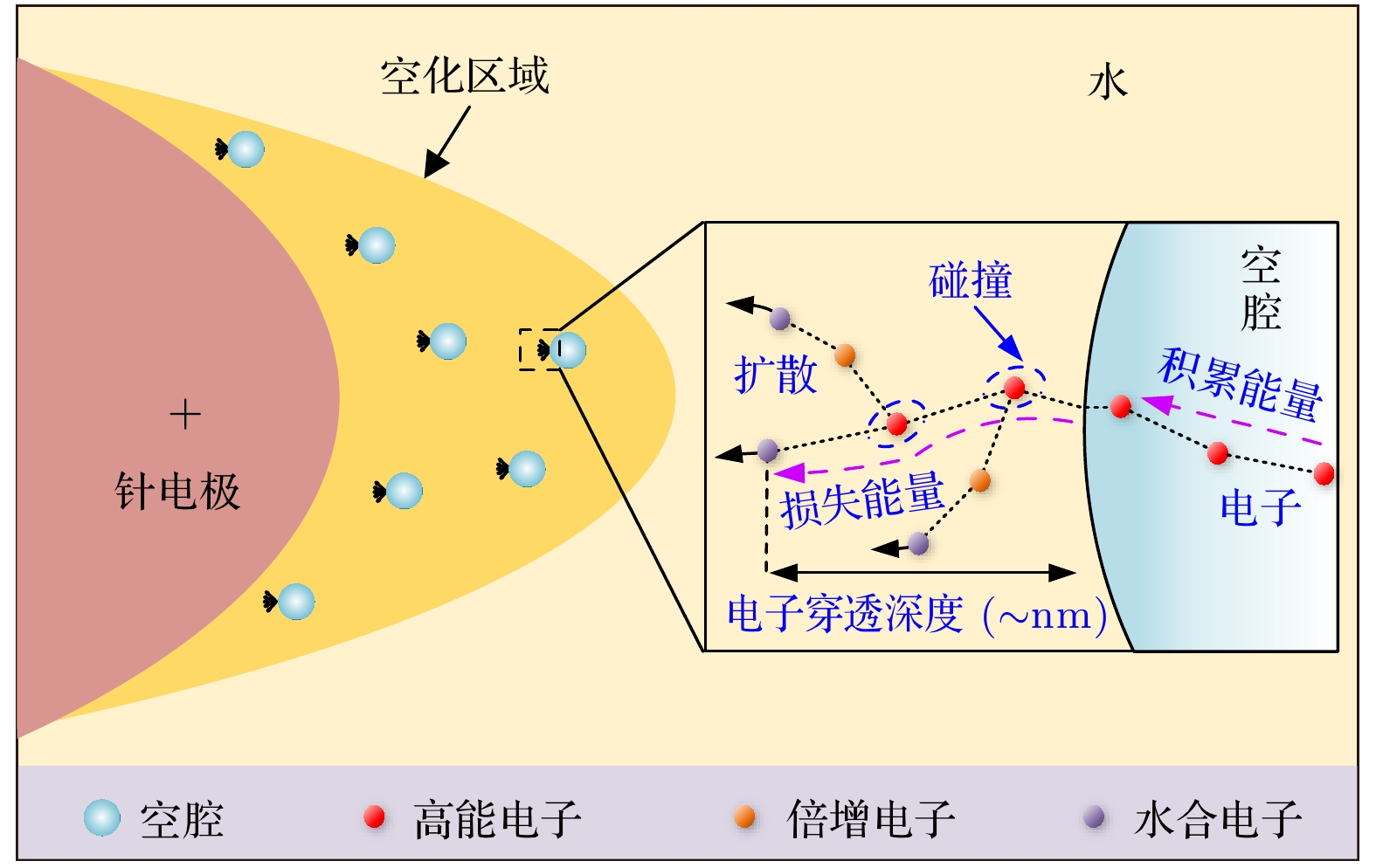
 下载:
下载:
